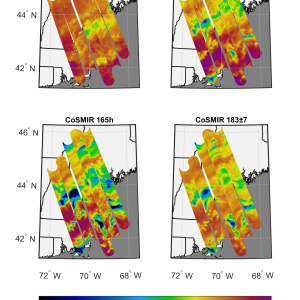CoSMIR is an airborne, 9-channel total power imaging radiometer that was originally developed for the calibration/validation of the Special Sensor Microwave Imager/Sounder (SSMIS). When first completed in 2003, the system had four receivers that measured horizontally polarized radiation at 50.3, 52.8, 53.6, 150, 183.3±1, 183.3±3, and 183.3±6.6 GHz, and dual-polarized (vertical and horizontal) radiation at 91.665 GHz. Following the SSMIS calibration/validation efforts, CoSMIR served as the airborne high-frequency simulator for the Global Precipitation Measurement (GPM) Microwave Imager (GMI) in four GPM field campaigns from 2011 to 2015. The channels were modified slightly to match the GMI channels more closely: 53.6 was removed, 91.655 changed to 89.0, 150 changed to 165.5 and made dual-polarized, and 183.3±6.6 changed to 183.3±7. In 2020 and 2022, CoSMIR flew on the NASA ER-2 in IMPACTS (Investigation of Microphysics and Precipitation for Atlantic Coast Threatening Snowstorms). CoSMIR’s submillimeter-wave sibling (CoSSIR) flew in the third deployment of IMPACTS in 2023.
CoSMIR is currently undergoing modifications through Decadal Survey Incubation (DSI) funds to become CoSMIR-Hyperspectral (CoSMIR-H). CoSMIR-H will retain the current 89 and 165 GHz dual-polarized channels and switch out the 50 and 183 GHz receivers for hyperspectral receivers spanning 50-58 GHz and 175-191 GHz, providing thousands of channels at these frequencies instead of the current two 50-GHz and three 183-GHz channels. Test flights of CoSMIR-H are tentatively scheduled for Summer 2024.
All the CoSMIR receivers and radiometer electronics are housed in a small cylindrical scan head (21.5 cm in diameter and 28 cm in length) that is rotated by a two-axis gimbaled mechanism capable of generating a wide variety of scan profiles. Two calibration targets, one maintained at ambient (cold) temperature and another heated to a hot temperature of about 323 K, are closely coupled to the scan head and rotate with it about the azimuth axis. Radiometric signals from each channel are sampled at 10 ms intervals. These signals and housekeeping data are fed to the main computer in an external electronics box.



